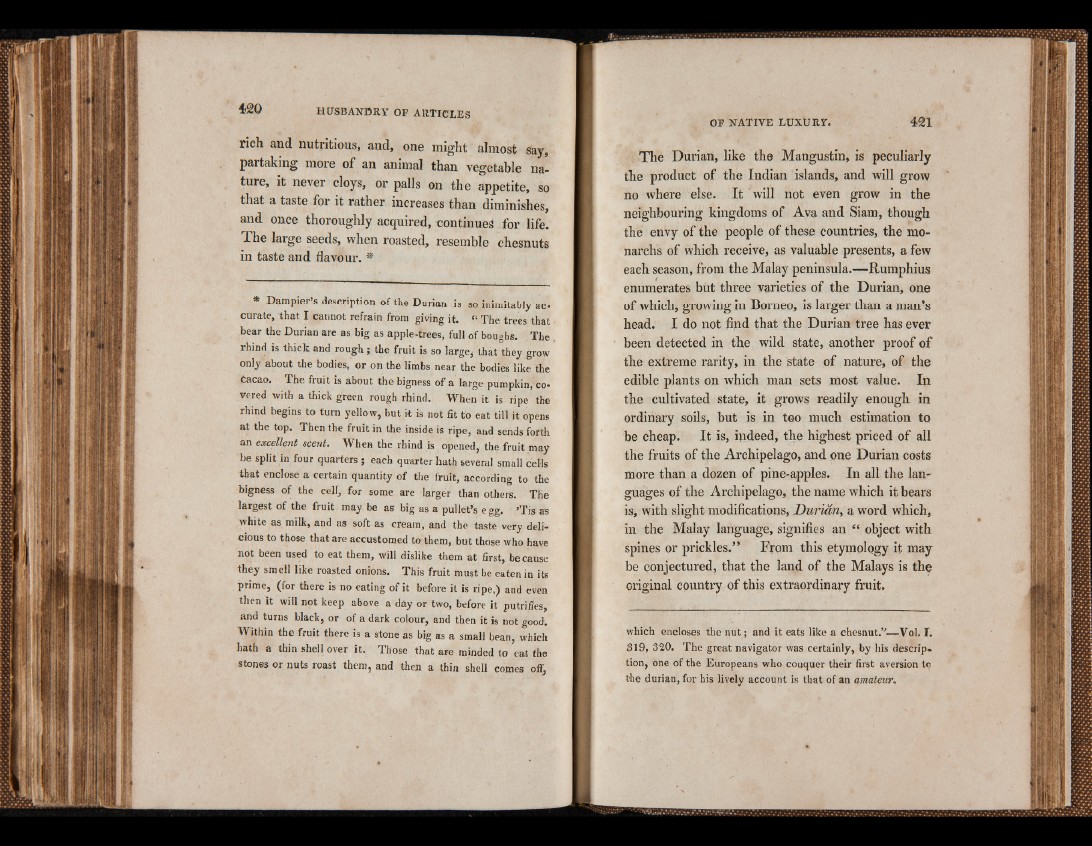
rich and nutritious, and, one might almost say,
partaking more of an animal than vegetable nature,
it never cloys, or palls on the appetite, so
that a taste for it father increases than diminishes,
and once thoroughly acquired, -continues for life.
The large seeds, when roasted, resemble chesnuts
in taste and flavour. *
* Dampier’s description of the Durian is so inimitably ac-
curate, that I cannot refrain from giving it. “ The trees that
bear the Durian are as big as apple-trees, full of boughs. The
rhind is thick and rough ; the fruit is so large* that they grow
only about the bodies, or on the limbs near the bodies like the
Cacao. The fruit is about the bigness of a large-pumpkin, covered
with a thick green rough rhind. When it is ripe the
rhind begins to turn yellow, but k is not fit to eat till it opens
at the top. Then the fruit in the inside is ripe, and sends forth
an excellent scent. When the rhind is opened, the fruit may
be split in four quarters ; each quarter hath several small cells
that enclose a certain quantity of the fruit, according to the
bigness of the cel 1, for some are larger than others. The
largest of the fruit may be as big as a pullet’s egg. ’Tis as
white as milk, and as soft as cream, and the taste very delicious
to those that are accustomed to them, but those who have
not been used to eat them, will dislike them at first, because
they smell like roasted onions. This fruit must be eaten in its
prime, (for there is no eating of it before it is ripe,) and even
then it will not keep above a day or two, before it putrifies,
and turns black, or of a dark colour, and then it is not good.
Within the fruit there is a stone as big as a small bean, which
hath a thin shell over it. Those that are minded to eat the
stones or nuts roast them, and then a thin shell conies off,
The Durian, like the Mangustin, is peculiarly
the product of the Indian islands, and will grow
no where else. It will not even grow in the
neighbouring kingdoms of Ava and Siam, though
the envy of the people of these countries, the monarch's
of which receive, as valuable presents, a few
each season, from the Malay peninsula.—Rumphius
enumerates but three varieties of the Durian, one
of which, growing in Borneo, is larger than a man’s
head. I do not find that the Durian tree has ever
been detected in the wild state, another proof of
the extreme rarity, in the state of nature, of the
edible plants on which man sets most value. In
the cultivated state, it grows readily enough in
ordinary soils, but is in too much estimation to
be cheap. It is, indeed, the highest priced of all
the fruits of the Archipelago, and one Durian costs
more than a dozen of pine-apples. In all the Ian-'
guages of the Archipelago, the name which it bears
is, with slight modifications, Durian, a word which,
in the Malay language, signifies an “ object with
spines or prickles.” From this etymology it may
be conjectured, that the land of the Malays is the
original country of this extraordinary fruit.
which encloses the nut ; and it eats like a chesnut.’'—.Vol. I.
319, 320. The great navigator was certainly, by his description,
one of the Europeans who conquer their first aversion to
the durian, for his lively account is that of an amateur.